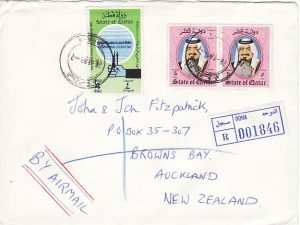Qatar
Located on a small peninsula along the western coast of the Arabian Gulf, Qatar’s rich postal history reflects its evolution from a modest fishing and pearling community under British protection to a prosperous independent state with vast oil and gas reserves. Under British rule since the early 20th century, Qatar used Indian stamps until the mid-1950s, when Pakistan took over Qatar’s postal services and issued overprints specifically for Qatar to differentiate its mail.
Qatar’s first independent postal issue was released in 1961, featuring the Sheikh of Qatar and marking the beginning of its journey toward autonomy. This era coincided with the discovery of extensive oil reserves, which transformed Qatar’s economy and influenced its stamp themes to reflect its new prosperity and growing cultural identity. Stamps issued during the 1960s and 1970s depicted themes of modernization, education, health, and infrastructure projects, as well as Qatar’s heritage and Bedouin traditions.
On September 3, 1971, Qatar gained full independence, and shortly thereafter, its stamps began to highlight its international identity, showcasing alliances within the Arab world and its membership in organizations such as the United Nations, the Arab League, and OPEC. From the 1980s onward, Qatar’s stamps emphasized its growing role on the global stage, commemorating events and figures important to the Islamic world, as well as achievements in sports, architecture, and science.
Qatar’s philatelic themes are diverse, ranging from local wildlife and environmental conservation to cultural festivals, Islamic art, and modern infrastructure, such as the striking skyline of Doha. The late 20th century saw Qatar embrace a broader range of international topics, including joint issues with other nations. With its modern stamps often printed in striking designs and vibrant colors, Qatar has crafted a philatelic legacy that celebrates its unique blend of tradition and rapid modernization in one of the world’s most dynamic regions.


